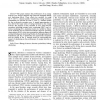Free Online Productivity Tools
i2Speak
i2Symbol
i2OCR
iTex2Img
iWeb2Print
iWeb2Shot
i2Type
iPdf2Split
iPdf2Merge
i2Bopomofo
i2Arabic
i2Style
i2Image
i2PDF
iLatex2Rtf
Sci2ools
TWC
2010
2010
Performance of an Energy Detector over Channels with Both Multipath Fading and Shadowing
This paper analyzes the performance of an energy detector over wireless channels with composite multipath fading and shadowing effects. These effects are modeled by using the and channel models. Closed-form average detection probabilities are derived for both and channel models for the no-diversity reception case. A simple approximation is also derived for large values of energy threshold in the energy detector. The analysis is then extended to cases with diversity receptions including maximal ratio combining (MRC) and selection combining (SC). Analytical results are verified by Monte Carlo simulation and by numerical methods. Receiver operating characteristic (ROC) curves are presented for different degrees of multipath fading and shadowing. Finally, the Rayleigh-lognormal distribution and the distribution are numerically compared, and the validity of the channel model for representing the impact of shadowing on the performance of energy detection is affirmed.
| Added | 23 May 2011 |
| Updated | 23 May 2011 |
| Type | Journal |
| Year | 2010 |
| Where | TWC |
| Authors | Saman Atapattu, Chintha Tellambura, Hai Jiang |
Comments (0)

